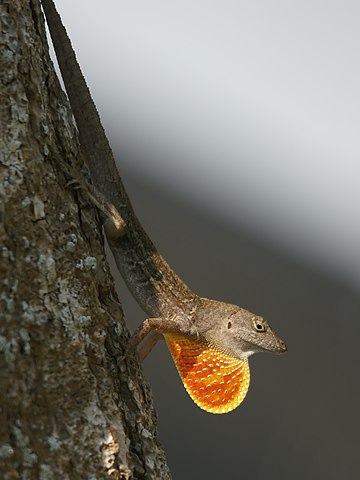We’ve long known that many reptiles need Ultra Violet B (UVB) light exposure in order to manufacture Vitamin D3. Vitamin D3, which is essential for proper calcium uptake, is also present in many foods, and some reptiles can utilize it in this form. However, there are some gray areas. It seems that reptiles long considered incapable of using dietary D3 (and which therefore need UVB light exposure), can sometimes obtain D3 from their diet (please see chameleon and day gecko articles linked below). Generalizations can be misleading – for example, the study summarized below shows that two anole species sharing the same habitat obtain D3 in very different ways.
Anole Study – Vitamin D3 and Basking Behavior
A study recently published in the Journal of Herpetology [47 (4) 524-29, 2013] examined whether the level of Vitamin D3 in the diet would affect the basking behavior of two anole species. Earlier research had shown that Panther Chameleons do alter their basking behavior in response to blood levels of Vitamin D3; please see the article linked below for details.
Wild and captive Brown Anoles, Anolis sagrei and Stripefoot Anoles, A. lineatopus, living in Jamaica were used as study subjects. When the D3 content of the diet was increased, Brown Anoles decreased the amount of time they spent basking in UVB light. This remained constant over a 6 week period. This indicated that they were obtaining enough D3 from their diet. When the dietary D3 was decreased, the Brown Anoles increased their exposure to UVB, so as to be able to manufacture D3 in the skin.
Stripefoot Anoles, on the other hand, did not decrease their basking time when fed high levels on D3, and they did not increase basking behavior when fed diets low in D3.
The researchers therefore concluded that Brown Anoles are able to use dietary D3, while Stripefoot Anoles cannot. Stripefoot Anoles seem to rely upon the Vitamin D3 that is produced in their skin when it is exposed to UVB light.
Studies such as this show us that we must carefully research the needs of each species under our care. Even if they are closely related, and share similar habitats, diets, and lifestyles, captive conditions that work for one could spell doom for another.
My Experience: Day Geckos Without UVB Did Well
I’ve made some related observations on Madagascar and Standing’s Day Geckos. UVB exposure has generally been considered critical to their welfare in captivity. Yet a colony of both, living at semi-liberty in a large zoo aviary, seems to be doing very well without access to UVB light. Please see the article linked below for further details.
Providing UVB to Lizards and other Reptiles
Natural sunlight is the best source of UVB, but it is important to bear in mind that overheating can occur quickly, and that UVB does not penetrate glass or plastic. Reptiles housed or placed outdoors must also be protected from rats, raccoons, dogs, cats, crows and other predators. Where conditions permit, screen cages offer a great means of providing natural UVB to your pets.
In recent tests, the Zoo Med 5.0 and 10.0 Bulbs were found superior to several other models. Mercury vapor and compact florescent bulbs generally emit higher levels of UVB than traditional florescent bulbs, and they broadcast it over greater distances. Mercury vapor bulbs also produce heat, and so may eliminate the need for an additional heat source.
Further Reading
Chameleon Basking Behavior Influenced by UVB Needs
My Notes: Day Geckos Thrive Without a UVB Source
 That Reptile Blog – Reptile, Amphibian and Exotic Pet Care and Information
That Reptile Blog – Reptile, Amphibian and Exotic Pet Care and Information






Nice study. I have conducted my own experiments of varied levels of D3 on my Geochelone pardalis.
Higher levels yielded lower instances of basking. Loeered levels increased the need for basking.
Thanks, Scott, Very interesting, and good to have this info on hand; do you have any details – rouigh or otherwise – on D3 amounts that you used, and the type of UVB exposure?
No hurry, but lots to learn, best, Frank
Frank, you mention “In recent tests, the Zoo Med 5.0 and 10.0 Bulbs were found superior to several other models.” Do you have a reference to that study? Thanks.
Hello Stephen,
Please see this article and those linked there. There have been advances (Zoo Med and others) in this area since the article was written.
Best, Frank